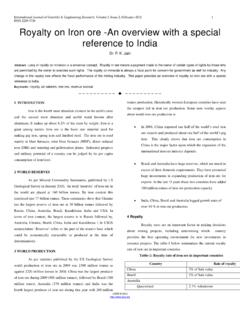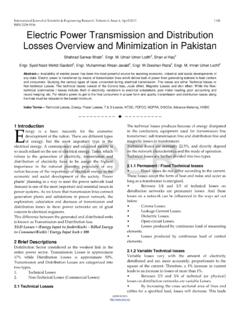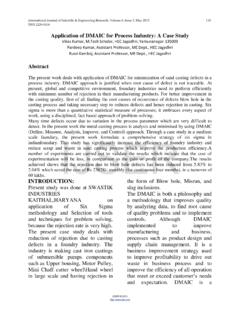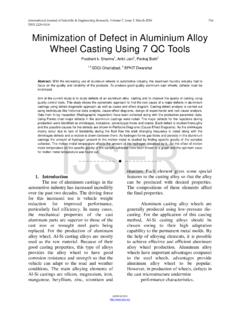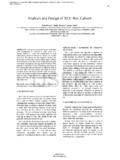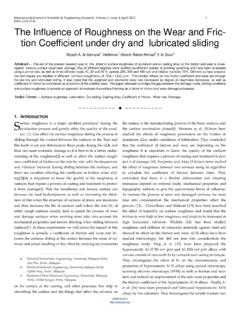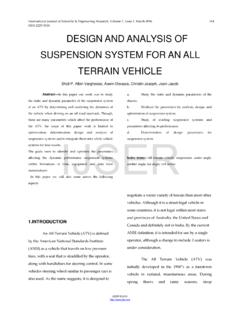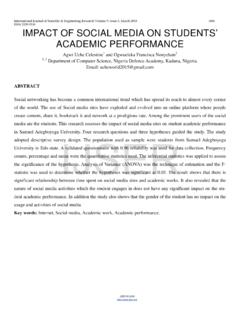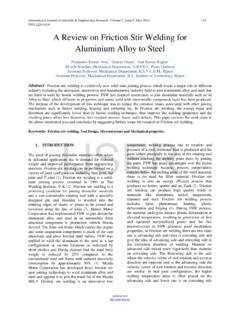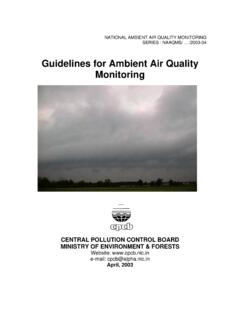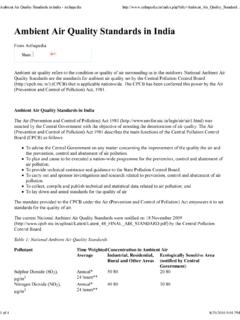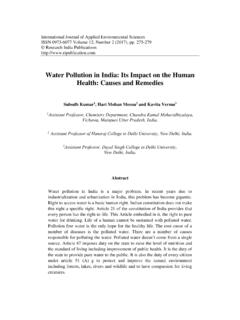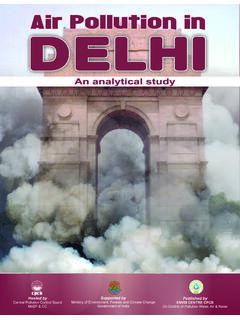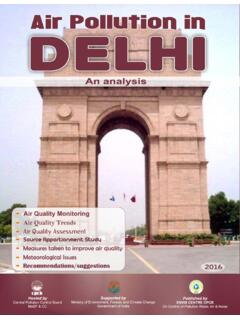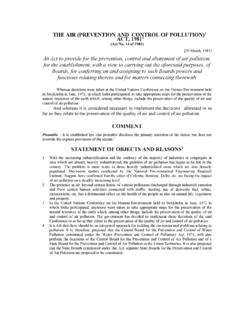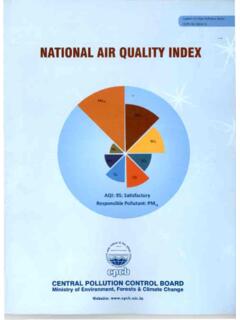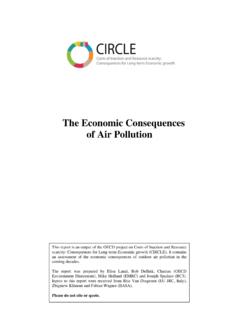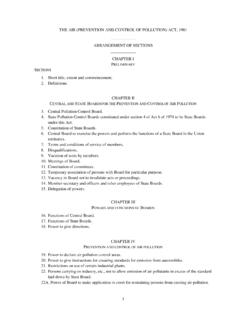Transcription of Air Pollution and Climate Change: Case Study National ...
1 International Journal Of Scientific & Engineering Research, Volume 9, Issue 6, June-2018 ISSN 2229-5518 IJSER 2018 Air Pollution and Climate change : case Study National Capital Territory of Delhi Sachin Kumar Abstract: The Ambient Air Pollution problem in National Capital Territory of Delhi is increasing at an alarming rate due to various anthropogenic activities and natural calamities; which significantly change the climatic condition and adversely influence the environmental condition. The Study is conducted by statistical analysis for Pollution profile of various parameters such particulate matter, nitrogen oxide, sulphur dioxide and carbon monoxide; by analyzing the these parameters particulate matter and nitrogen dioxide are not within the permissible limit due to various urban and rural activities in and around the National Capital whereas sulphur dioxide and carbon monoxide are within the permissible limits, but if the current scenario of Pollution will not stop then our National Capital will be going to face many Climatic problems in future.
2 The Study also discusses the various rules and policies adopted by the Government of india , National Green Tribunal and Government of Delhi to tackle the air Pollution and improve the air quality of National Capital Delhi. Keywords: Air Pollution , Climate change , Greenhouse Gases, Particulate Matter. 1 INTRODUCTION N india , Pollution has become a great topic of debate at all levels and especially the Air Pollution because of the enhanced anthropogenic activities such as burning of fossil fuels, natural gas, coal, and oil to power, industrial processes and motor vehicles. Among the harmful chemical compounds, this burning puts into the atmosphere as carbon dioxide, carbon monoxide, nitrogen oxide, sulphur dioxide and tiny solid particles-including lead from gasoline additives called particulates.
3 National Capital Territory of Delhi, the capital of india is sixth most polluted city in the world (World Health Organization, 2016) with approximately 25 million population and millions of people comes to Delhi every day for work and crosses Delhi every day to their work places. 2 AIR Pollution PROBLEM IN DELHI Air Pollution is a complex problem as it contains so many known and unknown parameters. The pollutants are added to the environment through various known and unknown natural processes as well as anthropogenic sources viz. industrial process, auto exhaust and domestic sources. According to the White paper on the Pollution prepared by the Ministry of Environment and Forest and Climate change (MOEFCC), Government of india , the ambient air quality of Delhi shows very high values of suspended solid particles which have been beyond the permissible limits from last several years continuously.
4 At all monitoring stations setup by the Central Pollution Control Board (CPCB), the concentration of nitrogen oxide (NOx) and particulate matter (PM) have been found to be consistently much higher than permissible limits. As things stand, air Pollution in the city is largely due to vehicles. Delhi now has more vehicles than Mumbai, Chennai, and Kolkata put together (Goyal, 2003). Industries have also been targeted for tackling air Pollution in Delhi. After tackling the issues of industries described as hazardous , Supreme Court of india directed the Delhi Pollution Control Committee (DPCC) to draw a list of industries that were setup in the areas categorized as non-conforming and residential areas.
5 The DPCC submitted its list of 97,600 industries before the court in 1977. The court directed Delhi government to either shift them to an alternative site or close them down. In addition to shifting of industries, a combination of setting up individual Effluent Treatment Plants (ETP), methods of control Pollution at different levels of production, fiscal measure have been followed in the industrial units. The CPCB pointed out that the three main thermal power plants uses electrostatic precipitators. The emissions are controlled. There might be a bit of particulate matter and oxides of sulphur that release into the air but the problem of Pollution from thermal power plants is not acute.
6 Industrial emissions too are not alarming, CPCB claims. Delhi does have any big industry. Of course, there are about a lakh of small-scale industries. The emission levels of these industries however, are not much of a problem (Suthirto, 2002). It is the vehicular Pollution both diesel and well petrol-induced which continues to be the major problem for the capital, which has the highest number of automobiles in the country (Goyal, 2003). Other major source of Pollution in Delhi is burning of crops in Haryana, Punjab and Uttar Pradesh and particulate matter due to construction activities. In winters, Delhi faces Great Smog because of burning of crop in Haryana, Punjab and Haryana, which causes 12-60% of Delhi air Pollution .
7 Farmer s burns rice stubbles at the end of the Kharif season before commencing I Er. Sachin Kumar, Masters in Environmental Planning, Department of Environmental Planning, School of Planning and Architecture, New Delhi, india . PH - +919958713044. E-mail: 844 IJSERI nternational Journal Of Scientific & Engineering Research, Volume 9, Issue 6, June-2018 ISSN 2229-5518 IJSER 2018 the planting of crops for Rabi season. The wind directs the smoke towards Delhi and workers the already polluted atmosphere air. With the number of vehicles, especially two wheelers increasing at an unprecedented rate, vehicular Pollution has become major contributor to deteriorating air quality in Delhi.
8 According to the White paper (MOEFCC), vehicular Pollution contributes to 64% of the total Pollution in Delhi in 1991 and 70% in 2000-2001. In view of the above discussion, it is necessary to define the status of ambient air quality due to the presence of different pollutants in the air environment of Delhi. The different organizations Central Pollution Control Board (CPCB), National Environmental Engineering Research Institute (NEERI), The Energy Research Institute (TERI) have been monitoring the ambient air quality at various locations in Delhi measuring levels of sulphur dioxide (SO2), nitrogen oxide (NOx), lead (Pb), ozone (O3), carbon monoxide (CO) and particulates matter.
9 The atmospheric concentrations of air pollutants show a high trend. The monitoring stations of CPCB, which are monitored regularly, are located at Ashok Vihar, Mayapuri Industrial areas- Shazadabad, Siri Fort, Janakpuri, Nizzamuddin and Shahdara are shown below: Figure1: Location of air quality monitoring stations by CPCB Source: CPCB Figure2: Average Concentration of SO2, NO2 and Particulate Matter in NCT of Delhi Source: CPCB Figure3: Average Concentration of Carbon Monoxide in NCT of Delhi A detailed analysis of monitored ambient air quality data gives the status of air quality of Delhi, which as follows: NO2 remain quite high near traffic intersections during peak traffic hours (morning and evening).
10 SO2 remains within the permissible limit. Particulate matter usually exceeds the permissible limit mainly due to natural dust, vehicular emissions, burning of crops and partly due to emissions from power plants and other industries. PM problem is more acute during summer period to natural disturbance in atmosphere. In general, one can see that air Pollution level is high during winter month and create winter syndrome due to low temperature, low mixing depth, Pollution inversion and high traffic density. Table 1: Emissions Norms for cars per kilometer Stages CO (gm/km) HC+NOx (gm/km) 1991 Norms (onlyHC) 1996 Norms 1998 Norms india Stage 2000 Norms BS-II BS-III BS-IV Source: CPCB Table 2.
